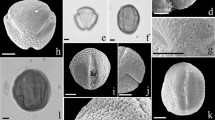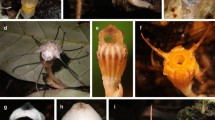Abstract
All genera ofAnnonaceae endemic in Australia (Ancana, Fitzalania, Haplostichanthus) show almost exactly the same type of disulcate (disulculate) pollen with intact exine extending over the sulci. Tetrad stages inHaplostichanthus andAncana reveal a latudinal subequatiorial orientation of the two sulci at the proximal hemisphere. Sometimes they fuse into a ±zonosulcate aperture.Fissistigma pollen grains are ±globose and have a flattened pole with a central elevation and a concentric groove, covered by a somewhat reduced exine. This palynological characters give further support for separating the generaAncana andFissistigma. Germination was observed inHaplostichanthus where the pollen tube emerges at one of the two sulci and inFissistigma where the flattened part breaks up during germination. The aperture types described here are obviously transitional stages between aperturate and inaperturate pollen grains and are discussed in regard to pollen evolution.
Similar content being viewed by others
References
Fries, R. E., 1959:Annonaceae. — InEngler, A., Prantl, K. (Eds.): Die natürlichen Pflanzenfamilien, 2nd edn.,17aII. — Berlin: Duncker & Humblot.
Hesse, M., Waha, M., 1984: Sporoderm characters ofTetrameranthus duckei (Annonaceae) and their systematic implications. — Pl. Syst. Evol.147: 323–326.
—, 1985: Pollen ultrastructure and systematic affinities ofAnaxagorea (Annonaceae). — Pl. Syst. Evol.148: 253–285.
Le Thomas, A., 1981: Ultrastructural characters of pollen grains of AfricanAnnonaceae and their significance for the phylogeny of primitive Angiosperms. — Pollen & Spores22: 265–342, and23: 5–36.
—, 1972: Sur la structure fine des tétrades de deux Annonacées (Asteranthe asterias etHexalobus monopetalus). — Comt.-Rend. Acad. Sci. Paris, sér. D,275: 1749–1752.
—, 1986: Pollen of palaeo- and neotropicalAnnonaceae: Definition of the aperture by morphological and functional characters. InBlackmore, S., Ferguson, I. K., (Eds.): Pollen and spores. Form and function. — Linn. Soc. Symposium Ser.12: 375–388.
Maas, P. J. M., Westra, L. Y. Th., (Eds.), 1984: Studies inAnnonaceae, II. A monograph of the genusAnaxagorea A. St. Hil. (Annonaceae). — Bot. Jahrb. Syst.105: 73–134.
Morawetz, W., 1988: Karyosystematics and evolution of AustralianAnnonaceae, as compared withEupomatiaceae, Himantandraceae andAustrobaileyaceae. — Pl. Syst. Evol.159: 49–79.
-Hesse, M., 1984: Primäre und sekundäre Aperturen bei Angiospermenpollen. InEhrendorfer, F. (Ed.): Mitteilungsband der Botanikertagung in Wien. Kurzfassung der Beiträge.
—, 1985: A new pollen type, C-banded and fluorescent counterstained chromosomes and evolution inGuatteria and related genera (Annonaceae). — Pl. Syst. Evol.150: 119–141.
Mueller, F., 1865–1866: Fragmenta Phytographiae Australiae. — Melbourne: J. Ferres.
Sampson, F. B., 1975: Aperture orientation inLaurelia pollen (Atherospermataceae syn. subfamilyAhterospermoideae ofMonimiaceae). — Grana15: 153–157.
Sinclair, J., 1955: A revision of the MalayanAnnonaceae. Garden's Bull. (Singapore)14: 149–516.
Waha, M., 1985: Ultrastruktur und systematische Bedeutung des Pollens beiBocageopsis, Ephedranthus, Malmea undUnonopsis (Annonaceae). — Pl. Syst. Evol.150: 165–177.
-Hesse, M., 1988: Aperture types withinSapranthus andPolyalthia (Annonaceae). — Pl. Syst. Evol. (in press).
Walker, J. W., 1971: Pollen morphology, phytogeography and phylogeny of theAnnonaceae. — Contr. Gray. Herb.202: 3–131.
—, 1974: Aperture evolution in the pollen of primitive Angiosperms. — Amer. J. Bot.61: 1112–1136.
—, 1975: The bases of Angiosperm phylogeny: Palynology. — Ann. Missouri Bot. Gard.62: 664–723.
Author information
Authors and Affiliations
Rights and permissions
About this article
Cite this article
Waha, M., Morawetz, W. Pollen evolution and systematics inAnnonaceae with special reference to the disulcate Australian endemic genera. Pl Syst Evol 161, 1–12 (1988). https://doi.org/10.1007/BF00936007
Received:
Issue Date:
DOI: https://doi.org/10.1007/BF00936007




